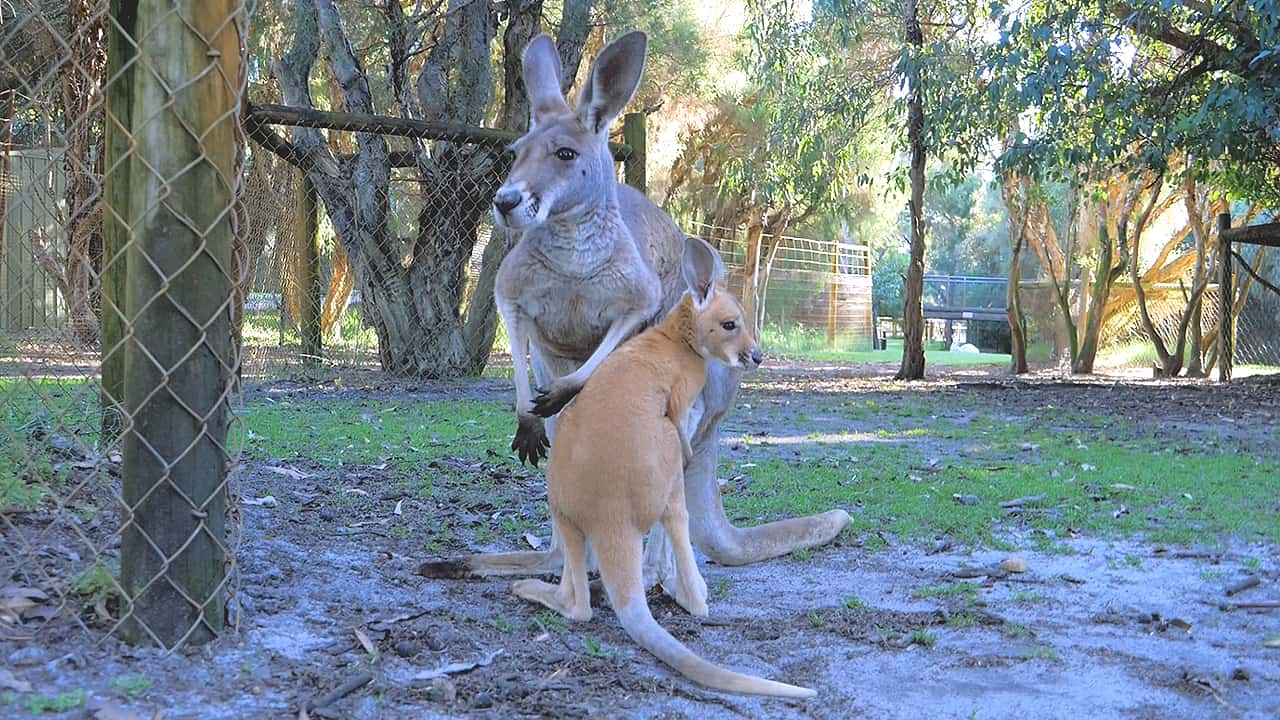Joey Kangaroo Caversham Wildlife Park Western Australia
Loading Video...
Joey Kangaroo Caversham Wildlife Park Western Australia
Red Kangaroo
The red kangaroo (Macropus rufus) is the largest of all kangaroos, the largest terrestrial mammal native to Australia, and the largest extant marsupial. It is found across mainland Australia, avoiding only the more fertile areas in the south, the east coast, and the northern rain-forests.
This species is a very large kangaroo with long, pointed ears and a squared-off muzzle. They are sexually dimorphic as the males have short, red-brown fur, fading to pale buff below and on the limbs. Females are smaller than males and are blue-grey with a brown tinge, pale grey below, although arid zone females are coloured more like males. It has two forelimbs with small claws, two muscular hind-limbs, which are used for jumping, and a strong tail which is often used to create a tripod when standing upright. The red kangaroo’s legs work much like a rubber band, with the Achilles tendon stretching as the animal comes down, then releasing its energy to propel the animal up and forward, enabling the characteristic bouncing locomotion. The males can cover 8–9 m in one leap while reaching heights of 1.8–3 m, though the average is 1.2–1.9 m.
Females have one baby at a time, Joey. Joey immediately climbs into its mother’s pouch and does not emerge for two months. Until they reach about eight months of age. Joeys will quickly dive for the safety of mom’s pouch. As they grow, joeys heads and feet can often be seen hanging out of the pouch.
Red kangaroos facts
Red kangaroo hops along on their powerful hind legs and does so at great speed. A red kangaroo can reach speeds of over 35 miles an hour. Their bounding gait allows them to cover 7.63metres – 25 feet in a single leap and to jump 2 metres – 6 feet high.
Female red kangaroos are smaller, lighter, and faster than males. They also boast a blue-hued coat, so many Australians call them “blue fliers.”
Larger male kangaroos are powerfully built. Like many species, male kangaroos sometimes fight over potential mates. They often lean back on their sturdy tail and “box” each other with their strong hind legs. Kangaroos can also bite and wield sharp claws, which they may do in battle with an enemy like a dingo.
Caversham Wildlife Park introduces visitors to the unique selection of wildlife in Western Australia, from iconic native species to farm animals and rich birdlife.
Joey Kangaroo Caversham Wildlife Park Western Australia
At times, red kangaroos congregate in large numbers; in areas with much forage, these groups can number as much as 1,500 individuals. Red kangaroos are mostly crepuscular and nocturnal, resting in the shade during the day. However, they sometimes move about during the day. Red kangaroos rely on small saltbushes or mulga bushes for shelter in extreme heat rather than rocky outcrops or caves. Grazing takes up most of their daily activities. Like most kangaroo species, they are mostly sedentary, staying within a relatively well-defined home range. However, great environmental changes can cause them to travel great distances. Kangaroos in New South Wales have weekly home ranges of 258–560 ha, with the larger areas belonging to adult males. When forage is poor and rainfall patchy, kangaroos will travel 25–30 km to more favourable feeding grounds. Another study of kangaroos in central Australia found that most of them stay close to remaining vegetation but disperse to find fresh plants after it rains.The red kangaroo is too big to be subject to significant non-human predation. They can use their robust legs and clawed feet to defend themselves from attackers with kicks and blows. However, dingoes and eagles will kill and eat joeys. Joeys are thus protected in their mother’s pouch. The red kangaroo formerly did have major predators that are now extinct.
About Caversham Wildlife Park
David and Pat own and operate Caversham Wildlife Park with their son David & daughter Debbie.
When they purchased the park in 1988, the park housed a small collection of animals and birds on a modest 5 acre (2ha) property. A few years later, the park doubled in size, when the family purchased the adjoining property and the collection started to boom. In May 2003, the family designed and built a new park in Whiteman Park, once again, more than doubling in size.
Opening Hours of Caversham Wildlife Park
Caversham Wildlife Park is open 9.00am to 5.30pm every day of the year except Christmas day (December 25).
Last entry into the park is at 4.30pm.
We recommend you arrive before 3.00pm if you wish to see and do everything (some attractions start to close from 3.00pm).
To make the most of your visit and enjoy all of the attractions, we recommend you allow at least 3 hours in the park.
Monday 9.00am – 5.30pm
Tuesday 9.00am – 5.30pm
Wednesday 9.00am – 5.30pm
Thursday 9.00am – 5.30pm
Friday 9.00am – 5.30pm
Saturday 9.00am – 5.30pm
Sunday 9.00am to 5.30pm
Come and spend the day at one of Perth’s most exciting tourist attractions, showcasing the largest private collection of native wildlife in Western Australia.
Hand-feed the kangaroos, join in the interactive farm show, touch a possum or lizard, meet a wombat, watch the cheeky penguins being fed, and have photos taken with koalas! Caversham Wildlife Park; a great Australian meet & greet experience for the whole family, in one fantastic day!
All of our shows, interactive experiences, photo opportunities and animal food are included in the entry fee! With no extra money needed around the park, you can make the most of your experience at Caversham Wildlife Park.
Caversham Wildlife Park is very proudly owned and operated by a Western Australian family. We don’t receive any Government assistance; the park is solely funded by visiting patrons! Thank you for your support and assistance!

0 Comments Be First to Comment